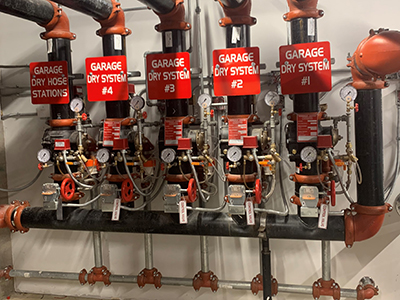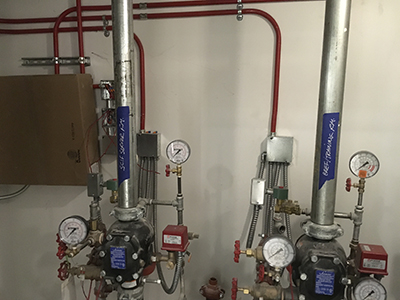
Wet Pipe Fire Protection Systems
Wet pipe systems are the most commonly used for of fire protection system. A wet pipe system operates by constantly maintaining water, under the required pressure, within the piping of the system. When a sprinkler activated water from within the system is them discharged from the activated sprinkler immediately. The systems are widely used for their simplicity and reliability, relatively low installation and maintenance costs and ease of modification.

Dry Pipe Fire Protection Systems
In a dry pipe system the system piping is filled with pressurized air or nitrogen, rather than water. The pressurized air or nitrogen holds the remote dry pipe valve in a closed position. The dry pipe valve, located in a conditioned space, prevents water from entering the system piping until a sprinkler head is activated. Once a sprinkler head activates, the air or nitrogen escapes and the dry pipe valve opens. This then allows water to flow into the system piping to the location of the activated sprinkler to suppress the fire. The most common application for a dry pipe sprinkler system is for areas which may be subject to freezing. Given that the dry pipe valve holds the water in a conditioned space, it will eliminate the risk of water freezing within the system piping.

Pre-Action Fire Protection Systems
Pre-action systems operate similarly to a dry pipe system, by holding the water at a remote valve rather than within the system piping. The difference is the type of valve which is used is an electronically operated valve, know as a pre-action valve. In a pre-action system two separate events must occur to initiate sprinkler discharge. First, the detection system must identify a developing fire and open the pre-action valve. This allows the water to flow into the system piping. Secondly, the sprinkler head(s) themselves must activate to then discharge the water onto the fire. Given that there are two events which must take place in order for a pre-action system to discharge, these systems are most prevalent in sensitive environments. Some examples are archival vaults, fine art storage rooms, rare book libraries and computer centers.

Deluge Fire Protection Systems
Deluge fire sprinkler systems are similar to pre-action systems except the sprinkler heads are open and the pipe is not pressurized with air. Deluge systems are connected to a water supply through a deluge valve that is opened by the operation of a smoke or heat detection system. The detection system is installed in the same area as the sprinklers. When the detection system is activated water discharges through all of the sprinkler heads in the system. Deluge systems are used in places that are considered high hazard areas such as power plants, aircraft hangars and chemical storage or processing facilities. Deluge systems are needed where high velocity suppression is necessary to prevent fire spread.

Fire Pumps
When there is not enough water at the local source for a fire protection system to operate, a fire pump may be required. Fire pumps are an essential part of many water-based fire protection systems. They are used to increase the pressure (measured in psi and bar) of the available water source. Once the water from the source is pulled into the suction side of the fire pump, it then churns and discharges the water at the adequate pressure into the fire protection system. This boost in pressure, given by the fire pump, allows the fire protection system to be ready to operate in the event of a fire related emergency.

Special Hazard & Suppression Based Fire Protection Systems
Special hazard fire protection systems are the perfect solution in areas or buildings where a standard, water based, fire sprinkler system is not an option. Special hazard systems are specifically designed to quickly detect and intercept fire or heat conditions, suppress fires when sprinklers are not appropriate as the first and only means of fire protection, mitigate business interruption, limit the loss of assets and most importantly protect people. Some examples of where special hazard systems are generally found include data centers, telecommunications, power generation, manufacturing and testing facilities, machinery spaces and healthcare facilities. These types of environments generally call for the need of specialized suppression agents, as an alternative to water. Some of these agents include foam, dry chemical, water mist, clean agent, CO2 and inert gases.

Fire Protection System Inspections
Regular inspections of your fire protection systems is not only a requirement, but it is also a need to ensure your life safety system maintains proper working order. Over time, all fire protection equipment will become subject to corrosion, use or possibly improper use. Some of the inspection activities such as draining low point drains on dry systems, weekly/monthly inspection of gauges and control valves, can be performed by property owners but the more technical inspections, tests, and maintenance should be performed by a qualified contractor. Allow National Fire Protection, LLC to provide regular inspections to your fire protection systems. Keeping your equipment properly maintained can limit damages and consequential repair work in the event of a fire. It also will help you avoid penalties and fines from fire authorities. It has also been a proven fact that fire protection systems save lives! Our inspection departments will operate with the utmost professionalism and provide you with a clear and concise outline of the condition of your systems to keep them operating at peak proficiency to protect your life and your property.

Fire Protection System Maintenance and Repairs
National Fire Protection, LLC is a fully integrated service company for all your fire protection requirements. Our highly trained and experienced staff is capable of execution all your service needs including extinguishers, fire sprinkler systems, backflow preventers and suppression. National Fire Protection, LLC will serve as a part of your building operations team and work to ensure your systems are ready to operate at moment’s notice. NFPA 25 provides the minimum requirements for routine inspection, testing, maintenance, and assessment of sprinkler systems and the frequency of those inspections, tests, and assessments. It places that responsibility on the property owner. As the inevitable happens, and service is required on your fire protections systems, National Fire Protection, LLC has fully equipped technicians who are experts in the installation of fire protection systems. Because they know how these systems are built, they know better than anyone how to repair and maintain them.

Fire Alarm Systems
Fire alarm systems warn occupants when smoke, fire, carbon monoxide or other fire related emergencies are detected. These alarms may be activated automatically from smoke detectors, and heat detectors or may also be activated via manual fire alarm activation devices such as manual call points or pull stations. Alarms can be either motorized bells or wall mountable sounders or horns. They can also be speaker strobes which sound an alarm, followed by a voice evacuation message which warns people inside the building. These systems can be an early warning to any occupants, that they need to evacuate furthering the safety of those who are in the building or structure.


